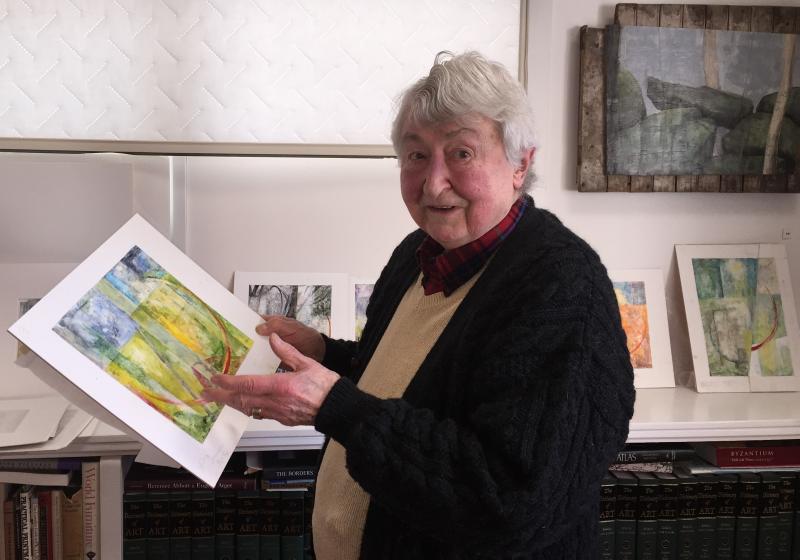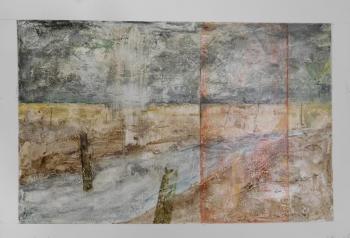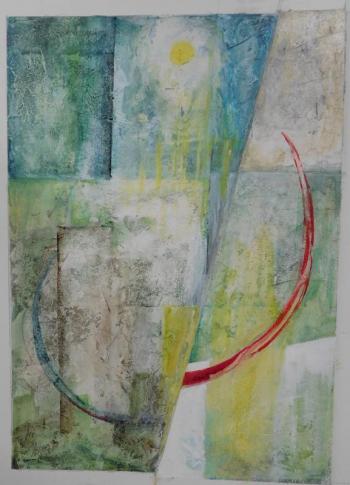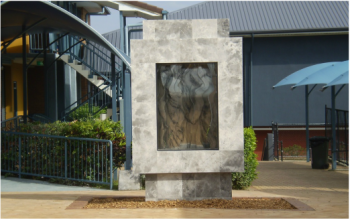Seeking the transcendent through her palette
Barters Island artist Brenda Bettinson has sought the transcendent in art all of her life — and it could be said she has also sought it in her personal life as well.
Her search for the transcendent in art has come from expected sources such as her understanding of the depiction of the human form in art created to serve sacred purposes, and unexpected sources such as an abandoned backhoe or farm truck, a rock wall or an elderberry bush on her dearly loved Barters Island.
She began to paint and draw as a small child; altogether she has been painting for 80 years! Over the decades Bettinson’s style has changed along with her subject matter. There have been periods of abstraction, of expressionism and intense realism. She has executed commissions for patrons such as the Vatican and for Calvary Hospital in the Bronx, N.Y. (this latter painting was 7½’ X 20’, acrylic on Masonite). In Washington DC, at the Benedictine abbey of St Anselm’s, there is now a room that has been named the Bettinson Room, where a selection of her work is hanging.
For two decades Bettinson focused her work on religious subjects, by chance at the beginning, and later, as she said, “one thing leads to another, I suppose.”
“It's impossible to go it completely alone,” Bettinson said. “If you’re lucky you make the right contacts — and you recognize them as such when you meet them.”
When she first came to the States, friends of Bettinson’s from their university days in Paris were instrumental in getting the British-born artist a gig producing the New York Fine Arts Guide for WRVR-FM, an educational radio station in NYC. Turns out the husband of a friend was the music director at the radio station. Next thing you know, a Jesuit priest sees Bettinson’s drawings and asked to meet her. This priest was the art editor of the magazine “America.” Bettinson still recalls (with great glee) that he not only asked her to write an article, she was paid for it — and quite handsomely!
In the 70’s Bettinson did a large painting, “Thomas- called Dydimus” (Doubting Thomas), showing the moment when he puts his hand into Christ’s wound. Thomas said he had to do it to believe. Bettinson’s version has Thomas being seen from the back with his hand on Christ’s torso. The head of Christ is not seen.
Five years ago Bettinson and Carl Little did an art and conversation program at the Boothbay Harbor Memorial Library that featured Bettinson’s paintings. After this event Cordula Mathias, gallery owner of Mathias Fine Art and Bettinson’s representative, received an email from the director of art and architecture of the Archdiocese of Brisbane in Australia. He had seen a photograph reproduction of the “Thomas” painting and was interested in using the image in the courtyard of the new Church of St Thomas, in Camp Hill, Brisbane. He was given permission to do so. The image was reproduced on steel and framed in marble. The total height of the reproduced work and marble when it was installed in 2013 was approximately 12 feet.
“Whether I paint something on Barters Island or something for the Vatican Pavilion it has to do with human experience and human limitation,” Bettinson said.
During the last half of 2015 she created a new series, “The Earth Remembers,” composed of 21 paintings in acrylics on illustration board. “This is new work, totally new in technique and approach to the subject, unlike anything I have previously done,” Bettinson said. ”It’s important not to keep doing the same thing over and over.” This series together with a selection of other works will be included in the first show this season at Mathias Fine Art on Barters Island.
The subject is war. Bettinson has already spent 10 years of studio time exploring in her art work the unceasing impact of war on human beings, their resources, and the nations of the world.
In 2014 -15, the centennial commemorations of World War 1 included imagery and photography that had previously been unseen but suddenly became available due to the great advances in technology since the early 21st century. Bettinson was drawn to the photos of soldiers in trenches, the ravaged land, the death and devastation brought on the people, the commandeered horses lying dead and rotting on the battlefields — and nature itself.
In 1971 Bettinson had visited the former battlefields of northern France. She wrote, “…Apart from the anomaly of the thousands of white crosses that stood row after row in the war graves cemeteries, their geometry and extent resembling some dreadful sci-fi harvest, the land appeared to be untouched.”
With the commemoration of the end of that war, Bettinson found her thoughts returning to those fields that contained beneath their surfaces the blood and bones of over 1 million men, horses, vehicles, and killing equipment.
“Mentally I began to translate that material into what might be possible as a painted surface: tentative, small paintings, abstract or semi-abstract, color-field work, expressive of the ravishing of the land,” shared Bettinson.
Brenda Bettinson has lived a rich, creative life. At age 86, she is an artist whose work has been reproduced in journals and newspapers, who has been an art reviewer for WRVR-FM when it was the educational radio station in NYC, a full professor and department head at Pace University in New York where she taught studio art and art history for 27 years. She is also a writer, poet and musician. She studied art in London, Paris and Rome. What else could she possible desire?
“One is always pursuing the grail you know,” Bettinson said with a grin and chuckle.
































